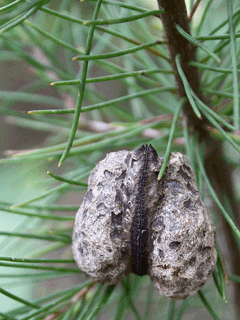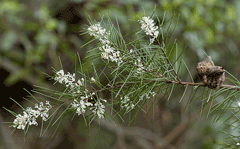 |
|
http://www.flickr.com/photos/lightcliff/ |
 |
| http://flickr.com/photos/petrichor/ |
Translate this page:
Summary
Physical Characteristics

 Hakea_sericea is an evergreen Shrub growing to 3 m (9ft 10in).
Hakea_sericea is an evergreen Shrub growing to 3 m (9ft 10in).
See above for USDA hardiness. It is hardy to UK zone 9. It is in leaf all year, in flower from June to July. The species is hermaphrodite (has both male and female organs) and is pollinated by Bees.
Suitable for: light (sandy), medium (loamy) and heavy (clay) soils and prefers well-drained soil. Suitable pH: mildly acid and neutral soils. It can grow in semi-shade (light woodland) or no shade. It prefers dry or moist soil. The plant can tolerates strong winds but not maritime exposure.
UK Hardiness Map
US Hardiness Map
Synonyms
H. acicularis. H. tenuifolia. Conchium aciculare. Banksia tenuifolia.
Plant Habitats
Edible Uses
References More on Edible Uses
Medicinal Uses
Plants For A Future can not take any responsibility for any adverse effects from the use of plants. Always seek advice from a professional before using a plant medicinally.
None known
References More on Medicinal Uses
The Bookshop: Edible Plant Books
Our Latest books on Perennial Plants For Food Forests and Permaculture Gardens in paperback or digital formats.

Edible Tropical Plants
Food Forest Plants for Hotter Conditions: 250+ Plants For Tropical Food Forests & Permaculture Gardens.
More

Edible Temperate Plants
Plants for Your Food Forest: 500 Plants for Temperate Food Forests & Permaculture Gardens.
More

More Books
PFAF have eight books available in paperback and digital formats. Browse the shop for more information.
Shop Now
Other Uses
A gum, somewhat similar to gum tragacanth (which is obtained from various Astragalus spp), is obtained from the stems[64, 154]. Shrubs are planted for the reclamation of arid land in Spain and Portugal[50]. Plants are used for screening purposes in Australia[157].
Special Uses
References More on Other Uses
Cultivation details
Succeeds in a hot dry position, requiring a lime-free soil[182]. Requires plenty of moisture in the growing season but a very well-drained soil[1]. Wind tolerant[166]. This species is not very hardy in Britain, but it succeeds outdoors in S.W. England[11]. Plants are hardy to about -7°c in Australian gardens but this cannot be translated directly to British gardens due to our cooler summers and longer, colder wetter winters. They grow well in a Mediterranean climate, with cool wet winters and hot dry summers[200]. Some forms of this species are lower growing with a tendency to sucker[157]. Sometimes confused with H. lissosperma, some plants grown as H. acicularis are H. lissosperma[11]. A good bee plant. Plants in this genus are notably resistant to honey fungus[200].
References Carbon Farming Information and Carbon Sequestration Information
Temperature Converter
Type a value in the Celsius field to convert the value to Fahrenheit:
Fahrenheit:
The PFAF Bookshop
Plants For A Future have a number of books available in paperback and digital form. Book titles include Edible Plants, Edible Perennials, Edible Trees,Edible Shrubs, Woodland Gardening, and Temperate Food Forest Plants. Our new book is Food Forest Plants For Hotter Conditions (Tropical and Sub-Tropical).
Shop Now
Plant Propagation
Seed - sow March in a greenhouse. Germination is usually good. When they are large enough to handle, prick the seedlings out into individual pots and grow them on in the greenhouse for at least their first winter. Plant them out into their permanent positions in late spring or early summer, after the last expected frosts[78]. Cuttings of mature wood[1].
Other Names
If available other names are mentioned here
Native Range
AUSTRALASIA: Australia (New South Wales, Queensland (southeast))
Weed Potential
Right plant wrong place. We are currently updating this section.
Please note that a plant may be invasive in one area but may not in your area so it’s worth checking.
Conservation Status
IUCN Red List of Threatened Plants Status :

Growth: S = slow M = medium F = fast. Soil: L = light (sandy) M = medium H = heavy (clay). pH: A = acid N = neutral B = basic (alkaline). Shade: F = full shade S = semi-shade N = no shade. Moisture: D = dry M = Moist We = wet Wa = water.
Expert comment
Author
Schrad.&J.C.Wendl.
Botanical References
1150200
Links / References
For a list of references used on this page please go here
Readers comment